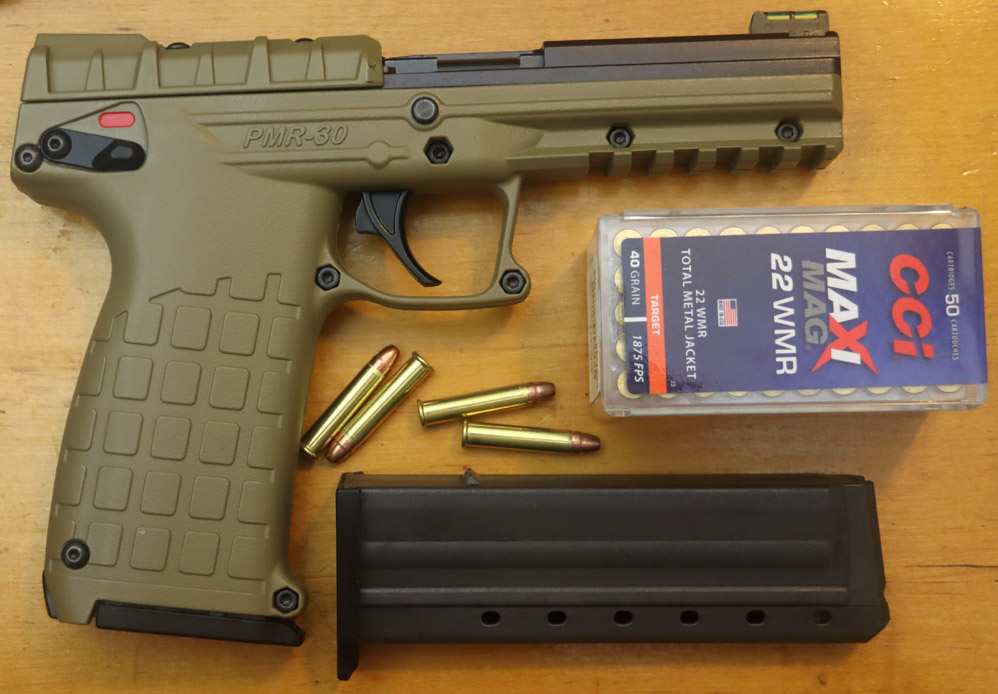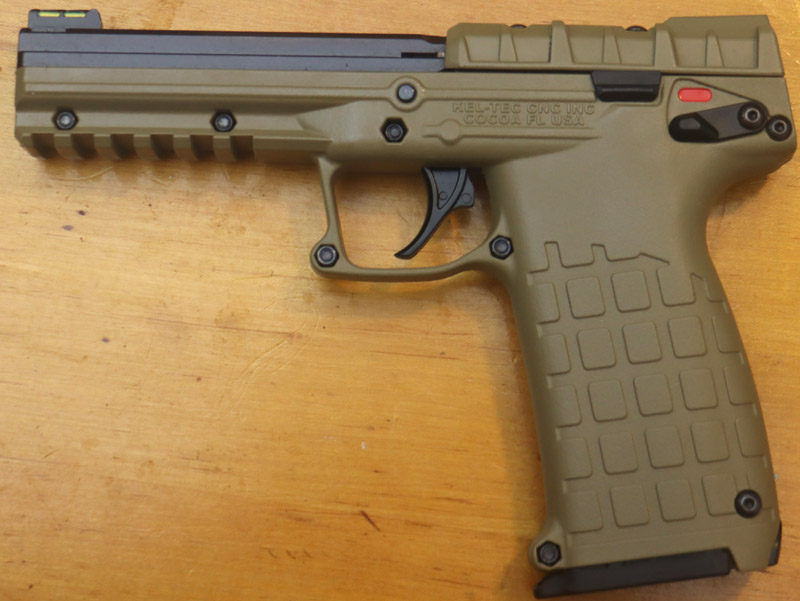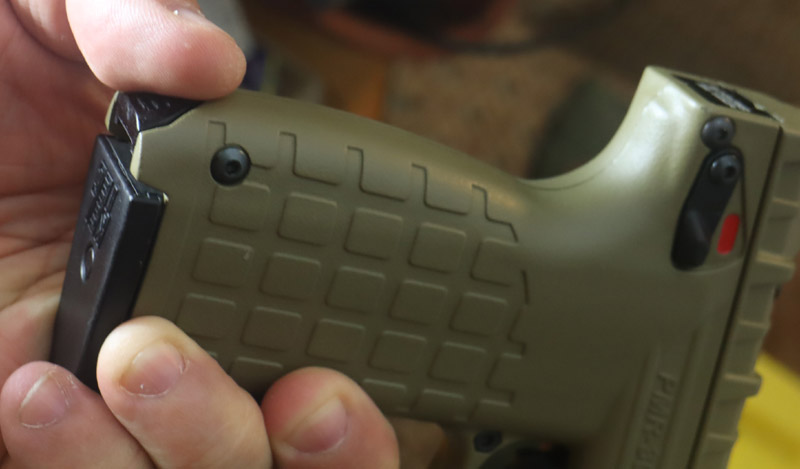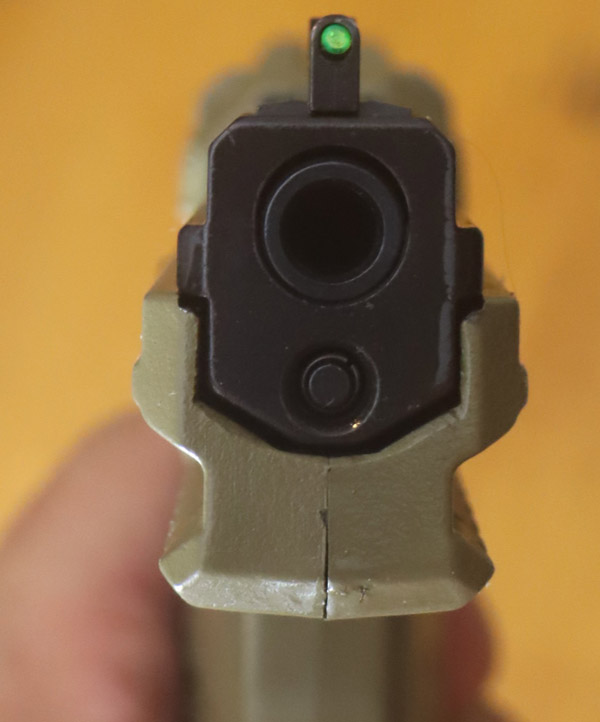
Kel-Tech PMR-30
| Dimensions | Barrel Length | Weight | Caliber | Action Type | Magazine Capacity |
| 7.9" x 5,8" x 1.3" |
4.3 Inches |
15.4 oz |
22 WMRF |
Semi |
30 |
The PMR-30 (Pistol Magnum Rimfire)
 is yet another
unusual and trend setting design by Kel-Tek. The company
has made a name for itself by creating firearms that don't
conform to the norm. In the case of the PMR-30, this is a
standard full sized semi auto handgun that holds thirty
rounds of ammunition in a flush fitting magazine. It fires
the 22 WMRF, which is a fairly well regarded round, with a
dedicated following.
is yet another
unusual and trend setting design by Kel-Tek. The company
has made a name for itself by creating firearms that don't
conform to the norm. In the case of the PMR-30, this is a
standard full sized semi auto handgun that holds thirty
rounds of ammunition in a flush fitting magazine. It fires
the 22 WMRF, which is a fairly well regarded round, with a
dedicated following.This is a single action only gun, with no de-cocker, and a regular thumb safely like an old fashioned 1911. The action is hammer fired, but the hammer is internal and can not be cocked manually, so it is not possible to carry this gun with the hammer down on an empty chamber. Surprisingly, in a rimfire, the barrel on this gun is not fixed, but recoils back partway with the slide. So this is a delayed action, like a big centerfire handgun, rather than straight blowback.
The trigger is curved plastic, rather flat with no levers or safeties. Trigger pull is crisp and breaks at around 3.5 pounds. It is a wonderful trigger. In part, this is due to the single action hammer fire action of the gun. I do note that everyone who shoots or reviews this gun comments on the quality of the trigger pull. The reason is simple enough. The action uses a simple notch held by a sear. This is the way most actions worked up until sometime in the seventies/eighties, when we started getting to striker fired guns and double action systems. A striker fired gun has a long trigger pull that generally stacks towards the end. Decades of experience making such guns have allowed for these pulls to be greatly improved, but they still suffer in comparison to a crisp sear fired hammer. Double action trigger systems tend to have a lot of slack and can be heavy, due to having to work the cocking mechanism of the double action.
The sights are a mixture of old and new. Physically, they are a notch and blade as have been around for over a hundred years. But the PMR-30 adds fiber optic dots to help line the sights up. In decent daylight, they are vivid and very helpful. There is no glow or intrinsic light source, so they offer little assistance in the dark. The front site is adjustable for drift, by loosening a pair of hex screws. I suspect some adjustment for elevation may be mad by shimming, but do not know this for certain. The rear site is molded into the top of the gun and can not be adjusted. There are four hex screws for mounting optical or red dot sight. There is not a cut out.

While the gun
has an ambidextrous safety, it is not what I would call
left hand friendly. The slide release is only operable
from the right hand, and the empties eject to the right.
The magazine latch is located European style at the bottom
of the grip, making it equally accessible to right or left
handed shooters. It is plastic, like most of the gun, and
is serrated. Operation is by pressing up and forward. For
those of us weaned on American style magazine releases
located by the trigger guard, it takes a bit of practice.
On the other hand, with thirty rounds on tap, how often
will a reload be required?
 The magazine itself is thin, light, and constructed of
plastic. As a double column magazine feeding a rimmed
cartridge, it also take as bit of getting used to, as the
rounds must be loaded straight down, rather than being
slid in from front to back, as in most semi auto handguns.
The process feels a bit like the loading of an AR-15
magazine.
The magazine itself is thin, light, and constructed of
plastic. As a double column magazine feeding a rimmed
cartridge, it also take as bit of getting used to, as the
rounds must be loaded straight down, rather than being
slid in from front to back, as in most semi auto handguns.
The process feels a bit like the loading of an AR-15
magazine.
As thin and
light as they are, the magazines also have a bit of the
feel of an AR-15 magazine. There are six indicator holes
on the dies of each magazine. Ordinarily, these might
stand for one round each. On these magazines, each hold
indicated five rounds.
Extra magazines
are available for around $32. Have a total of five,
including the two that came with my CMR-30 and my PMR-30.
These hold a total of 150 rounds, and easily fit into
pouches on my belt. This should me more than enough for a
fun day at the range, or for defensive use if it comes to
that. I can't really see this for hunting, even small
game, but you never know.

The polymer
frame is in two halves. The line visible down the center
is not a molding mark. It is the seam between the tow
halves of the gun frame. As can be seen in the photos at
the top, these are held together by a series fo hex
screws. Disassembly is through removal of a pin that sits
just below the slide. The hex screws are never touched.
The decision to
go with almost entirely polymer construction is a mixed
bag. On the one hand, the gun is VERY light, and I will
have little worry about corrosion, though the slide and
barrel are steel. The down side is that the gun does not
have the reassuring heft of a steel gun, and does possess
a bit of a toy gun quality. I do recall similar criticism
of the M-16 was loudly voiced in the sixties, and the gun
has proven itself. The seam is also very visabel on the
bottom of the gun, along withi the mounting point for a
laser or flashlight. The rounded triangle shape of the
grips also shows here, as well as the bottom mounted
magazine release.

How it shoots
 The gun shoots well enough,. when it shots. The sights are
wonderful, there is almost no recoil, and the trigger is
very nice. These combine for tight groups and a fun day at
the range. I was able to get pretty much all of my shots to
go through one hole. The sights in particular were a huge
help.
The gun shoots well enough,. when it shots. The sights are
wonderful, there is almost no recoil, and the trigger is
very nice. These combine for tight groups and a fun day at
the range. I was able to get pretty much all of my shots to
go through one hole. The sights in particular were a huge
help.The grip shape is unusual, being kind of a rounded triangle. In a semi, the grip shape is based around the magazine shape. Most autos have somewhat slab sided grips, due to their magazines. The rims and general taper on the little 22 Magnum rounds make for a magazine that is wider at the back. This isn't necessarily a bad thing, but gives the gun unique handling properties.
One thing I noticed, which has been mentioned by other reviewers, is a strange quality to the feel of the gun. There is quite a bit of blast, but not so much apparent recoil, probably as a result of most factory loads being tailored for the longer barrels of rifles.. A handloader could fix this by the use of faster burning powders, but this is a rimfire and can not be handloaded. The gun is easy to shoot, but as such, this gun begs for a silencer. As 22 magnum handguns get more popular and numerous, ammunition suppliers will eventually come up with loads more suited to their shorter barrels.
Kel-Tek offers a threaded barrel for this, and a selection of muzzle breaks (as if one was needed) and flash hiders to help with the blast. The first thing that comes to mind with a threaded barrel is the use of a silencer. Kel-Tek says no. They warn that back pressure from a silencer will interfere with the cycling of the gun. I presently own a silencer, and may end up getting the threaded barrel, just to see. I do note that I have no issues with my silencer on the CMR-30, the big brother of this gun.
Extended magazines of up to fifty rounds are available by aftermarket companies. Thirty seems like plenty to me, and a long magazine will greatly harm the ergonomics of the gun and interfere with proper holstering. For the carbine version, the CMR-30, such an option may be more viable. Incidentally, that makes this pair a pistol/carbine combo, using the same ammunition, and even the same magazines. For me that adds greatly to the fun and the utility.
I will be working with this gun, taking special care to clean it, and being very careful about how I load the magazines. The reason for this is the unreliability. Kel-Tek makes a very big deal about the thirty round magazine this gun features, but it is rare for me to be able to fire more than five rounds without a failure to feed or (more often) a failure to eject. Rimfires can be finicky about cleaning, and the construction of teh magazines makes them suspect. As of right now I CANNOT recommend this gun, except as a novelty if you find one selling cheap. The most important thing a self defense handgun can do is shoot when teh trigger is pulled. This one can not be depended upon to do that.
If a cleaning does not fix, I will trade this in on the S&W. I have already bought a Walther 22 Magnum, and may shelve or rehome this Kel-Tek. I will update this page after trying a few things.
For most of its history, the 22 Magnum for handgun use was relegated to revolvers, or a few specialty guns like the old AMT Auto Mag. The guns did poorly on the market, in part due to expense, and to expense of the ammunition, but also because similar sized guns could be had in larger calibers and the 22 magnum was not given the respect its high muzzle energy should have conferred, often being looked upon as a sort of a glorified 22 long rifle.
A lot of the old thinking has gone away. For six decades our main military rifle (the M-16) has been in 22 caliber, and the new 5.7 x 28, basically a 22 caliber, is the new military standard in personal protective weapons calibers. New technologies allow for higher velocities, higher pressures, and better bullet construction than was once the case. While I am not ready to trade in my old 45 A.C.P. for a 22, the table below makes some interesting comparisons.
In the photo to the left, are the standard 22 long rifle on the right, along side the 22 Magnum in the center, and the newer 17 Magnum rimfire to the left. The magnum operates at a bit higher pressure. The 17 Magnum is a necked down 22 magnum that can reach startling velocities, but has an extremely light bullet. In addition to its increased length, the 22 magnum has a wider base then the standard 22 long rifle.
| caliber |
bullet weight |
velocity |
energy |
| 22 Long Rifle |
40 grain |
1140 FPS |
115 Foot pounds |
| 380 |
95 grain | 950 FPS |
190 Foot pounds |
| 9mm |
124 grain | 1200 FPS |
397 Foot pounds |
| 38 special |
158 grain | 1020 FPS |
365 Foot pounds |
| 5.7 |
40 grain |
1950 FPS |
340 Foot pounds |
| 22 WMRF |
40 grain |
1910 FPS |
324 Foot pounds |
The table above is close to the truth, but does not tell the whole truth. The 22 WMRF is a rimfire cartridge and thus can not be handloaded. The listings above are for standard commercial or military loads. Centerfire cartridges give the option of using special .loads,custom loads, and loading one's own. The table also does not include any consideration for the frontal area factor, which many consider to be important. Basically, the frontal area camps says that, no matter how fast the bullet is going, a big hole is better than a little hole. The high velocity camp argues that a fast bullet is better than a slow bullet, and that energy tells the tale.
I tend to fall into the former camp, and prefer heavy bullets and large calibers to high velocity. However, both camps are right to a certain extent. A higher velocity is always better than a lower velocity, a bigger hole is always better than a smaller hole, and a heavy bullet is always better than a light bullet. The problem is that you can't have it all. There are trade offs. The arguments are about what these trade offs should favor.
Things that sold me on the Kel-Tek
Price ($500 vs. $650)
Same magazines as their carbine (If you want a rifle/carbine combo)
fiber sights (Front and rear vs front only)
Things that almost sold me on the S&W
Stainless steel upper (Less worry about corrosion)
Mottling on grip (Very nice and secure grip finish)
Tempo barrel (Recoil reduction)
Company - S&W vs. Kel-Tek (Hate to sound like a gun snob)
Obviously, I chose the Kel-Tek, though if S&W ever came out with a 22 WMRF carbine that took the same magazines I might be persuaded to switch camps. If they also knocked the price down just a bit, that would add another incentive.